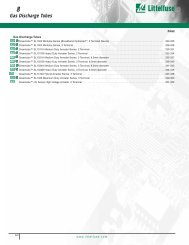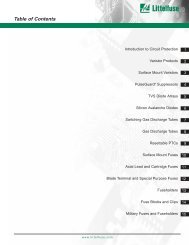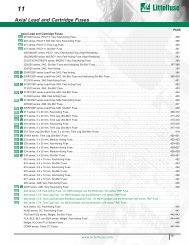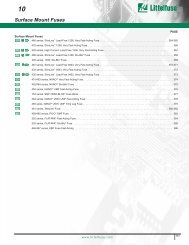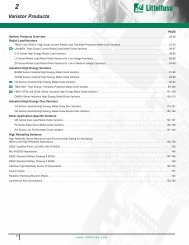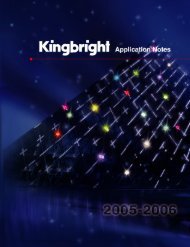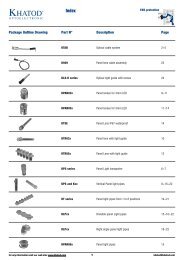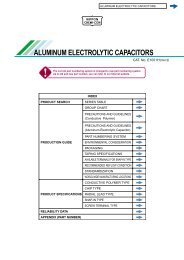TVS Diode Arrays
TVS Diode Arrays
TVS Diode Arrays
Create successful ePaper yourself
Turn your PDF publications into a flip-book with our unique Google optimized e-Paper software.
<strong>TVS</strong> <strong>Diode</strong> <strong>Arrays</strong><br />
Electronic Protection Array for ESD and Overvoltage Protection<br />
SP720<br />
Absolute Maximum Ratings<br />
Thermal Information<br />
Continuous Supply Voltage, (V+) - (V-). ........................+35V Thermal Resistance (Typical, Note 1). ....................θJA (<br />
Forward Peak Current, IIN to VCC , IIN to GND<br />
(Refer to Figure 6) . .................................±2A, 100µs<br />
ESD Ratings and Capability (Figure 1, Table 1)<br />
Load Dump and Reverse Battery (Note 2)<br />
oC/W) PDIP Package . ............................................90<br />
SOIC Package . ..........................................130<br />
Maximum Storage Temperature Range . . . .. ..............-65oC to 150oC Maximum Junction Temperature (Plastic Package) . ....................150oC Maximum Lead Temperature (Soldering 10s) . .........................300oC (SOIC Lead Tips Only)<br />
CAUTION: Stresses above those listed in “Absolute Maximum Ratings” may cause permanent damage to the device. This is a stress only rating and operation of the device<br />
at these or any other conditions above those indicated in the operational sections of this specification is not implied.<br />
NOTE:<br />
1. θJA is measured with the component mounted on an evaluation PC board in free air.<br />
Electrical Specifications T A = -40 o C to 105 o C; V IN = 0.5V CC , Unless Otherwise Specified<br />
PARAMETER SYMBOL TEST CONDITIONS MIN TYP MAX UNITS<br />
Operating Voltage Range,<br />
VSUPPLY = [(V+) - (V-)]<br />
VSUPPLY - 2 to 30 - V<br />
Forward Voltage Drop:<br />
IN to V-<br />
IN to V+<br />
ESD Capability<br />
V FWDL<br />
V FWDH<br />
ESD capability is dependent on the application and defined test<br />
standard. The evaluation results for various test standards and methods<br />
based on Figure 1 are shown in Table 1.<br />
For the “Modified” MIL-STD-3015.7 condition that is defined as an<br />
“in-circuit” method of ESD testing, the V+ and V- pins have a return path<br />
to ground and the SP720 ESD capability is typically greater than 15kV<br />
from 100pF through 1.5kΩ. By strict definition of MIL-STD-3015.7 using<br />
“pin-to-pin” device testing, the ESD voltage capability is greater than 6kV.<br />
The MIL-STD-3015.7 results were determined from AT&T ESD Test<br />
Lab measurements.<br />
The HBM capability to the IEC 61000-4-2 standard is greater than 15kV<br />
for air discharge (Level 4) and greater than 4kV for direct discharge<br />
(Level 2). Dual pin capability (2 adjacent pins in parallel) is well in excess<br />
of 8kV (Level 4).<br />
For ESD testing of the SP720 to EIAJ IC121 Machine Model (MM) standard,<br />
the results are typically better than 1kV from 200pF with no series resistance.<br />
I IN = 1A (Peak Pulse)<br />
Input Leakage Current IIN -20 5 20 nA<br />
Quiescent Supply Current IQUIESCENT - 50 200 nA<br />
Equivalent SCR ON Threshold Note 3 - 1.1 - V<br />
Equivalent SCR ON Resistance VFWD/IFWD; Note 3 - 1 - Ω<br />
Input Capacitance CIN - 3 -<br />
pF<br />
Input Switching Speed<br />
NOTES:<br />
tON - 2 -<br />
ns<br />
2. In automotive and battery operated systems, the power supply lines should be externally protected for load dump and reverse battery. When the<br />
V+ and V- pins are connected to the same supply voltage source as the device or control line under protection, a current limiting resistor should<br />
be connected in series between the external supply and the SP720 supply pins to limit reverse battery current to within the rated maximum<br />
limits. Bypass capacitors of typically 0.01µF or larger from the V+ and V- pins to ground are recommended.<br />
3. Refer to the Figure 3 graph for definitions of equivalent “SCR ON Threshold” and “SCR ON Resistance.” These characteristics are given here<br />
for thumb-rule information to determine peak current and dissipation under EOS conditions.<br />
www.littelfuse.com<br />
-<br />
-<br />
2<br />
2<br />
TABLE 1. ESD TEST CONDITIONS<br />
STANDARD TYPE/MODE R D CD ±VD MIL STD 3015.7 Modified HBM 1.5kΩ 100pF 15kV<br />
Standard HBM 1.5kΩ 100pF 6kV<br />
IEC 61000-4-2 HBM, Air Discharge 330Ω 150pF 15kV<br />
HBM, Direct Discharge 330Ω 150pF 4kV<br />
HBM, Direct Discharge,<br />
Two Parallel Input Pins<br />
330Ω 150pF 8kV<br />
EIAJ IC121 Machine Model 0kΩ 200pF 1kV<br />
H.V.<br />
SUPPLY<br />
°±V D<br />
CHARGE<br />
SWITCH<br />
R 1<br />
C D<br />
R D<br />
-<br />
-<br />
DISCHARGE<br />
SWITCH<br />
IEC 1000-4-2: R1 50 to 100MΩ<br />
MIL STD 3015.7: R1 1 to 10MΩ<br />
IN<br />
DUT<br />
V<br />
V<br />
FIGURE 1. ELECTROSTATIC DISCHARGE TEST<br />
229<br />
5<br />
<strong>TVS</strong> DIODE ARRAYS




